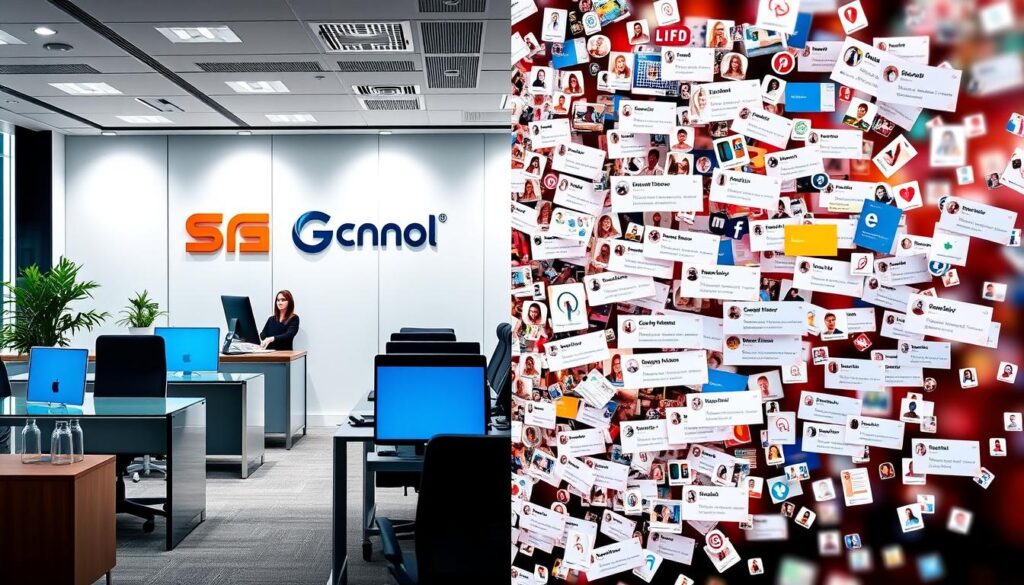Ever wondered why some brands do well while others don’t in the digital world? It’s all about the balance between brand image and online reputation. These two ideas are often mixed up but are key to how people see a brand and its success.
In today’s digital world, how a company shows up online can make or break it. With 97% of people finding local businesses online, having a strong online presence is vital1. But what’s the difference between brand image and online reputation, and why do businesses need to know?
Brand image is what a company wants people to think of it. Online reputation is what customers and others say about it. Both affect how people see a business, but one is more in control than the other. Knowing this helps build trust with customers and succeed online.
Think about this: 84% of people don’t trust traditional ads, but 74% trust a business with good reviews1. This shows how powerful online reputation is today. It’s clear that managing both brand image and online reputation is key for digital success.
Key Takeaways
- Brand image is company-controlled, while online reputation is influenced by external factors
- 97% of consumers find local businesses online, emphasizing digital presence importance
- Positive reviews boost trust for 74% of consumers
- 84% of job seekers consider employer brand reputation important
- 94% of consumers choose brands based on online comments and opinions
- Effective management of both elements is crucial for business success
Defining Brand Image and Online Reputation
Brand image is what people think of a company. It comes from their experiences and interactions. A strong brand identity makes a company stand out, helping customers pick them over others2.
Online reputation is what people say about a brand online. It comes from customer feedback, reviews, and social media. Today, 94% of consumers choose brands based on what they read online3.
Brand values are key to a good image and reputation. Companies with consistent branding get more customer attention. This consistency sends a clear message and builds trust2.
Managing a brand’s reputation is crucial for success. Brands need effort to build a good online image. Good online relationships can create brand defenders who speak up against negative info3.
While a company controls its brand image, online reputation comes from public opinion. Both affect customer loyalty and sales. A strong online presence can increase a brand’s trust and market position23.
The Role of Control in Brand Image and Reputation
Managing a brand is like walking a tightrope. You have to balance what you can control with what others say. Personal branding gives you more control than managing a company’s reputation4. Brands shape their image through marketing, quality products, and great customer service. But, what people think and say can change how others see a brand.
Trying to control what people think about your brand is tough. It’s shaped by what others say and do4. What people say online can greatly affect how a brand is seen in real life4. This shows how key it is to manage how people see you, especially with social media around4.

Having a good brand strategy means knowing yourself and sticking to your values4. Brands with a strong reputation usually do better than others. People trust them and see them as reliable5. This trust leads to loyal customers who are willing to pay more for what they offer5.
But, many companies aren’t ready for PR crises. A 2019 survey found that 55% of companies didn’t have a plan for such situations6. This shows we need to be proactive in managing our reputation.
| Aspect | Brand Image | Online Reputation |
|---|---|---|
| Control Level | High | Low |
| Influencing Factors | Marketing, Product Quality | Public Opinion, Customer Feedback |
| Management Approach | Proactive | Reactive and Proactive |
In the end, while you have more control over your brand image, keeping an eye on your online reputation is key. Both are vital for success. 97% of business owners see managing a brand’s reputation as crucial6. By understanding this, companies can make better strategies to improve their brand and customer relationships.
Brand Image vs. Online Reputation: Key Differences and Similarities
Brand image and online reputation are key to how people see a company. They have some things in common but are also quite different. Let’s look at these differences and similarities to see how they affect trust and brand strategy.

Brand image is shaped by companies through marketing and planned experiences. It aims to create a certain view in customers’ minds. Online reputation, on the other hand, is about managing what people say about you in real time. Both are crucial for shaping how customers trust and see a brand78.
A strong brand image can make customers more loyal and willing to pay more. Companies with good reputations can bounce back from crises better. How people act is often swayed by what they think of a brand, making a good image more likely to lead to sales9.
| Aspect | Brand Image | Online Reputation |
|---|---|---|
| Control | Proactive | Reactive |
| Focus | Planned messaging | Real-time feedback |
| Measurement | Brand trackers | Reputation trackers |
| Impact | Customer experience | Stakeholder assessment |
Both brand image and online reputation need ongoing work and to match company values. Ways to boost these include having a unique brand, great customer service, and being open. Using social media and analyzing market data helps manage how people see your brand9.
In today’s digital world, brand image and online reputation are closely linked. A strong brand can help with reputational issues, and a good reputation can boost brand building. By focusing on both, companies can make a strong strategy for success.
Building a Strong Brand Image
Creating a strong brand image is key in today’s market. We must define our core values and have a consistent look that speaks to our audience. This begins with a brand identity that matches our mission and values.
Being true to our brand promises is crucial. We must make sure our products and service are top-notch. High-quality products and service build trust and loyalty. But, poor quality can hurt our brand10.
Our marketing should keep our brand consistent everywhere. This means our website, social media, ads, and how we talk to people in person. A unified look and message strengthens our brand and leaves a lasting impression.
How customers feel about us shapes our brand. Every interaction changes how they see us. Good experiences make people loyal and vocal supporters. Bad ones can hurt trust. We should always aim for great customer service and easy-to-use products to keep people coming back10.
Remember, 1 in 3 companies think they can just decide their brand image in a meeting. But, what customers think really matters. It affects what they buy and how loyal they are11. We must really listen to what our customers say to shape our brand right.
By living our brand and keeping our promises, we can build a strong image. This makes us stand out and connect with consumers.
Managing Your Online Reputation
Managing your online reputation is key today. In our digital world, what customers say online can greatly affect your business. To stay on top, it’s vital to actively manage your reputation and keep an eye on social media.

Keeping a good online image is crucial. Google is the top review site for 63% of consumers, followed by Yelp, TripAdvisor, and Facebook12. It’s important to watch multiple sites to keep your reputation in check.
Social media greatly shapes how people see your brand. Over a third of people use social networks to learn about brands13. Being quick to respond is important, as 69% of consumers want a fast reply from brands online13.
Handling crises well is part of managing your reputation. By responding to reviews honestly, you can improve how customers see you12. This helps avoid big problems and keeps trust.
| Aspect | Importance | Strategy |
|---|---|---|
| Review Monitoring | High | Monitor multiple platforms (Google, Yelp, TripAdvisor) |
| Social Media Engagement | Critical | Respond promptly to mentions and messages |
| Crisis Management | Essential | Address issues openly and honestly |
| Brand Monitoring | Ongoing | Use tools to track mentions across platforms |
Managing your online reputation well means doing a lot of things. Focus on listening to customers, watching social media, and being active. This way, you can keep a good image online.
The Impact of Social Media on Brand Image and Reputation

Social media has changed how we see brands and interact online. With 4.48 billion users worldwide, these platforms are key for reaching customers and making brands known14. Every day, algorithms look at 500 million tweets, 4.3 billion Facebook posts, and 95 million Instagram photos, changing how we see content15.
Now, managing a brand’s image and reputation online is vital. Most consumers, 74%, use social media to decide what to buy, and 92% trust friends and family’s advice found online14. This shows how crucial it is to have a good online image.
Good social media marketing can really help brands get noticed and keep customers loyal. Companies that talk to their audience online can see sales go up by 20-40%14. But, they also need to watch out, bad news can spread fast and hurt their reputation.
| Social Media Impact | Percentage |
|---|---|
| Consumers influenced by social media presence | 73% |
| Consumers using social media to communicate with brands | 90% |
| Consumers trusting online reviews as much as personal recommendations | 79% |
To make the most of social media, brands should create fun, new content and work with influencers. Keeping an eye on what people say online and quickly fixing issues can help protect a brand’s reputation. By doing these things, companies can use social media to improve their brand and keep a good online image.
Conclusion: Integrating Brand Image and Online Reputation Strategies
We’ve looked at how brand image and online reputation work together. In today’s digital world, they’re more connected than before. A huge 93% of consumers let online reviews guide their purchases, and 86% avoid businesses with bad feedback16. This shows how important strong brand management and reputation strategies are.
Our marketing must match our reputation management to build trust with customers. Companies that manage their online well see a 33% revenue increase16. This shows the real benefits of keeping a consistent brand across all platforms. By answering reviews and talking with customers online, businesses can boost their chances of sales by 80%16.
To do well online, we need to focus on our online presence. Keeping an eye on brand mentions is crucial, as is making content that highlights the good things about our brand17. By using SEO best practices, we can make sure our positive content is easy to find, strengthening our brand and online reputation17. In this fast online world, answering quickly to feedback is key for a great reputation and keeping customer trust.
FAQ
What is the difference between brand image and online reputation?
Can a company fully control its online reputation?
How do brand image and online reputation impact a business?
What are some strategies for building a strong brand image?
How can a company effectively manage its online reputation?
How does social media impact brand image and online reputation?
Why is it important to integrate brand image and online reputation strategies?
Source Links
- Online Reputation Management: How to Protect Your Brand | InMoment – https://inmoment.com/blog/online-reputation-management/
- Brand Identity vs. Brand Image: What’s the Difference and Why Does It Matter? – 2Stallions – https://2stallions.com/blog/brand-identity-vs-brand-image-whats-the-difference-and-why-does-it-matter/
- Online Reputation: What It Is And How To Protect It | Getlinko – https://getlinko.com/en/what-is-online-reputation/
- Personal Brand vs Reputation: Differences, Similarities and How to Manage Both – Latinpresarios – https://latinpresarios.com/personal-brand-vs-reputation/
- Brand reputation in focus: Why it matters, what factors impact it, how to measure it—and how it drives success – https://www.agilitypr.com/pr-news/public-relations/brand-reputation-in-focus-why-it-matters-what-factors-impact-it-how-to-measure-it-and-how-it-drives-success/
- 3 Proactive Ways to Protect Your Brand Image and Reputation – Prowly – https://prowly.com/magazine/protect-brand-image-and-reputation/
- The major difference between reputation and image | Sherlock Communications – https://www.sherlockcomms.com/difference-reputation-image/
- What Is The Difference Between Brand And Reputation? Here’s Why CMOs Should Care – https://www.forbes.com/sites/shannbiglione/2023/04/27/what-is-the-difference-between-brand-and-reputation-and-why-should-cmos-care/
- Attaining That Number One Position in the Field of Branding – Strategies for Dominance – https://www.liendesign.com/blog/2017/11/28/brand-image-and-reputation-whats-the-difference
- Building Brand Reputation: Elevate Your Image | Mailchimp – https://mailchimp.com/resources/brand-reputation/
- Brand Image vs Brand Identity -With Examples & Explanation – https://www.linkedin.com/pulse/brand-image-vs-identity-with-examples-explanation-landis-eigsti
- 10 Steps to Improve Your Online Reputation Right Now – https://www.invoca.com/blog/improve-online-reputation
- Everything you need to know about online reputation management – https://sproutsocial.com/insights/online-reputation-management/
- The Role of Social Media in Shaping Corporate Reputations – https://psico-smart.com/en/blogs/blog-the-role-of-social-media-in-shaping-corporate-reputations-11738
- The Impact of Social Media Algorithms on Brand Reputation – https://www.reputationsciences.com/social-media-algorithms-reputation/
- Reputation Management: Strategies for Brand Success in 2023 – AMW – https://www.amworldgroup.com/blog/reputation-management-strategies-for-brand-success
- Navigating the Challenges of Online Reputation Management – https://www.linkedin.com/pulse/navigating-challenges-online-reputation-management-lisa-benson-ewy7c

